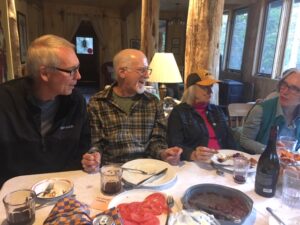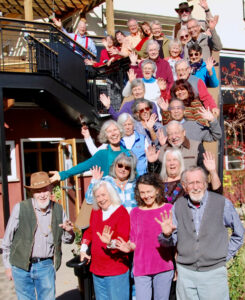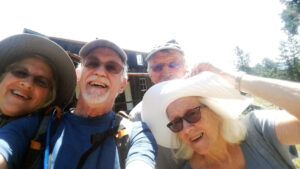Aging in Community at Silver Sage



Silver Sage Village, an urban senior cohousing community in Boulder, is among the earliest senior cohousing communities in the country, opening in 2007 with 16 owner-occupied units. Ten are market rate and six are permanently affordable, plus there are now two basement apartments as rentals. At present we have 28 residents, including 10 couples, 8 single women and no single men. The age range is currently 56 to 89. We are self-managed through five “standing teams,” contracting out a few basic services such as snow removal, but doing most of the work of managing our community ourselves.
It is helpful to share and read what other communities are doing, because we recognize that aging in a cohousing community contains many unknowns—it is a true social experiment. In fact, we would like to learn what the experience of senior communities has been in Europe—is the rumor true that some now have reverse-age restrictions, where new members have to be below a certain age? And how did Glacier Way evolve, the 8-unit community in Davis, CA where everyone was advanced in age when it started more than 25 years ago?
Our experience is that aging in community affects both the individuals and the community. For most Sagers the benefits of aging in community have outweighed the challenges, but we had five households (six residents) leave in 2019 for a local continuing-care community. The residents who left not only wanted more built-in care options as they aged, they no longer wanted the physical and emotional work that is an integral part of cohousing. Our new residents all want to be in cohousing and are participating fully in our community life.
When asked about the benefits, Sagers mention the many social aspects of living and working together as we grow older, including receiving help after illnesses or surgeries—as well as being able to provide that help. It is also beneficial to be able to learn from one another’s experiences, resilience and resources. Residents also appreciate that aging is normalized and that deeper conversations are encouraged, including reading together and discussing books such as Being Mortal and Counting on Kindness.
“Aging in Community” became a focus at Silver Sage following the CohoUS regional conference with that name in May 2016 in Salt Lake City. While there had been some activities around aging and end-of-life issues before that, most Sagers were focused on getting the community up and running—or they didn’t feel old enough to focus on that. By nearly ten years in, the conference topic had become much more relevant to residents here.
Because the conference was held within driving distance, ten of us were able to attend and formed our “CareNetwork” once we returned. The CareNetwork originally concentrated on three areas: 1) attending to the well-being and needs of community members, both now and as we age; 2) organizing activities to explore aging; and 3) sharing information and resources. In line with this last goal we developed extensive “CareNetwork Resources Pages” listing local and online resources, with recommendations by Sagers who have used them.
Everyone is considered a member of the CareNetwork, and many people gladly step up when someone needs “neighborly services” on a short-term basis. We have a health care independence agreement under which Silver Sage residents must be able to care for themselves or hire adequate help if they need long-term assistance. The CareNetwork operates under the umbrella of the Community Enhancement Team (CET), one of our five standing teams. Attendance at the monthly CareNetwork meetings has varied over the years, and the group stopped for a while when Covid hit, while the Steering Team guided the response to the pandemic. The current CareNetwork has asked CET to organize activities around aging in community while the CareNetwork has been focusing on residents’ needs and well-being, including establishing an Emergency File with everyone’s contact information and making a list of services people are willing to provide short-term, such as shopping, bringing meals, walking a dog, etc.
In the past we have brought in speakers on topics such as: safety issues (CPR and the defibrillator, as well as honoring DNR orders); in-home care and the role of a care manager; talking about end-of-life wishes (The Conversation Project); and the role of dreams in conscious aging (Rick Moody). In the months before one of our residents died, the CareNetwork supported her husband’s wish to provide natural after-death care by showing two documentaries to the community and helping during her three-day vigil in the Meditation Room and funeral in the Common House.
Silver Sage has always had high expectations of participation, and our “Participation Agreement” spells out certain activities, such as attending monthly community meetings when in the area, serving on one or two teams, and performing Common House duties two weeks a year. This agreement has, from its first draft in 2018, always ended with the clause:
“As a resident of Silver Sage I am responsible for my participation and accountable to the community as a whole. If, due to health, schedule or other causes I become limited in my ability to participate as described above, I will strive to find alternative ways to contribute to the good of the Community and will communicate with Steering about my situation.”
Last year the community again expressed support for this agreement as providing both the clarity and flexibility we need. While it by no means eliminates every gray area, it does provide guidelines and encourages us to consider individual circumstances and social capital built up over the years, as well as the needs of the community. However, it does not resolve the inherent tension between individuals’ autonomy and the community or eliminate the need for conversations which may be difficult to have. As part of these ongoing conversations, when we talk with prospective residents about Silver Sage we now make a special effort to be sure they understand our self-management model and are willing to participate in it. Our newest residents are all fully engaged in the work and life of the community.
The work to manage our community has evolved over the past 15 years as an expression of members’ talents and interests. For example, we currently benefit greatly at less cost from the commitment and knowledge of our Garden and Grounds Team members who, with ages from the mid-60s to mid-80s, enjoy the work they do and the appreciation they get from the community. Our communication, accounting, and financial management are done well at very little expense because of the talent of one or two members with strong backgrounds in computers and financial management.
At this point the increasing age of our residents does not seem to be an obstacle to our continued self-management of our community. While we no longer operate snow removal equipment ourselves, we have members who are willing and able to oversee snow removal and landscaping contractors. Some of our oldest members have taken on some of the most challenging oversight.
Although few can say that they always enjoy going to meetings, most members find that they are able to tolerate the meetings that are part of operating a successful community and we are learning to provide accommodations for those for whom meetings are increasingly challenging. We are learning that flexibility in our procedures and communications is essential as we age.
As our community evolves we find ourselves expanding our understanding of what it means to contribute and to participate as we age. By valuing residents’ contributions to the arts and social activities in our community as well as to tangible physical or mental work, we find ourselves relaxing and cutting one another more slack—in fact, that has become one of our stated values now! As a community we seem to find ourselves becoming more tolerant and more appreciative of one another—at once “friendlier and more realistic,” as one resident described it. As we learn more to recognize and value many different forms of participation, we are striving to appreciate each other’s styles of contributing and to assume that residents volunteer out of a desire for service rather than to maintain power and control. We’ve also come to realize that no one is irreplaceable and hope that Silver Sage will be here long after all of us current residents have come and gone!
Holding numerous sharing and listening circles has enabled us to learn more about one another and begin to explore more challenging issues as we age. As is usually the case, Sagers bring a wealth of viewpoints to any discussion. We are working to distinguish among worrying about the future, taking whatever actions need to be taken now, and trusting that we as a community will be responsive to needs as they change. For example, the idea of hiring a property manager seems to come up every few years in part because some members as they age are less able or willing to do the work of managing our community but want to remain living here and participating in the social life of the community. Some members think we need to investigate hiring a property manager now, in part to be prepared for a future in which we might not be able to be self-managed, while others find it difficult to see how we can plan now for a solution that might or might not be needed some years down the road. The fact that recent new residents have been more able and willing to participate in a broad range of work in our community has helped lower the pressure to address the issue of a property manager in the short term.
We are discovering that the worries we have about the community as our median age increases are similar to the existential anxieties we have around our personal aging. Not only do we worry about what kind of a community we will become and who will “take care of us” as a community, we find we’re having to look continually at what we value as a community. We are committed to supporting each other as we age in community together, coping together with the challenges that aging brings!
Category: Aging in Community
Tags: Aging
Views: 5483

